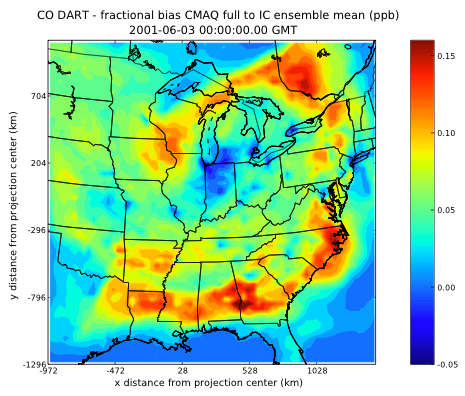Assimliation of CO
This project describes an integrated approach to modeling atmospheric chemistry with trace gas data assimilation. Specifically, we ran CMAQ from within DART to assimilate both synthetic and real observations of CO for the period of June 2001.
Alexis Zubrow


Fractional bias between the mean of the ensembles with and without data assimilation and the original full CMAQ run.
An integrated approach to modeling atmospheric chemistry with trace gas data assimilation is a relatively new focus of the atmospheric chemistry modeling community. It is expected that the predictive capability of CTMs can be significantly improved by assimilating measurements of key trace gases from satellite-based platforms and surface monitors. Ensemble adjustment Kalman filter (EAKF) methods are simple to implement, don’t need adjoints and backward integration, and are capable of handling non-Gaussian model errors. These factors have led to the adoption of EAKF methods for weather and climate simulations. Additionally, EAKF provides a measure of error resulting from the assimilation. We have combined EAKF data assimilation with a single-tracer version of CMAQ. The Data Assimilation Research Testbed (DART), developed by NCAR, was used to create an EAKF enabled CMAQ for assimilating CO. DART provides a modular environment that can integrate dynamical models with various assimilation techniques. Specifically, we ran CMAQ in ensemble adjustment Kalman filter mode to assimilate both synthetic and real observations of CO for the period of June 2001. We argue that it is a viable approach for further data assimilation experiments and potentially for air quality forecasting.
- Zubrow, A., L. Chen and V. R. Kotamarthi, 2008
EAKF-CMAQ: Introduction and evaluation of a data assimilation for CMAQ based on the ensemble adjustment Kalman filter,
J. Geophys. Res., 113, D09302, doi:10.1029/2007JD009267